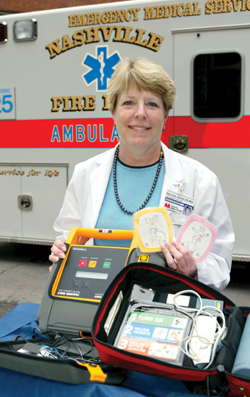
Mary Fran Hazinski holds an automated external defibrillator, which is designed to analyze the victim’s heart rhythm and determine if a shock is needed. The device, studied at VCH, automatically charges to the correct shock dose and prompts the rescuer to deliver a shock, if needed, or to continue CPR. Photo by Anne Rayner
Study: use of automated external defibrillators in children is accurate
A research study performed at Vanderbilt Children’s Hospital, proving the accuracy of automated external defibrillators (AED’s) in reading and interpreting heart rythms in children, has helped change American Heart Association guidelines.
Mary Fran Hazinski, a Vanderbilt Children’s Hospital Clinical Nurse Specialist and the lead author of the study, said the new research findings provided some of the evidence necessary for the AHA to recommend the use of AED’s in children 1 to -8 years old.
“Children don’t often collapse with sudden cardiac arrest, but when they do, they can be saved with immediate bystander CPR and use of the AED,” Hazinski said .
“There have been several reports in the press of young boys developing sudden cardiac arrest after they are hit in the chest with baseballs or hockey pucks,” Hazinski said. “If immediate bystander CPR is given and an AED can be used within minutes, many of these children can survive.”
The Vanderbilt study involved more than 200 children at Vanderbilt Children’s Hospital. AEDs were placed on the children during cardiovascular surgery and with parental permission during treatment in the PCCU. The devices used in the study were used only to record the heart rhythm, and the shocking mechanism was disabled. Hazinski and her team found the AEDs correctly interpreted almost all of the heart rhythms, even very rapid and abnormal rhythms.
The research is published in this month’s Annals of Emergency Medicine. This study was cited in the new AHA recommendations advising the use of AED’s in children over the age of one, published on July 1.
“The AHA has fairly strict requirements before they will make a scientific statement about the safety of such a device or treatment,” said Hazinski. “Our study was large enough that it helped the evidence reach the critical threshold needed to support a new recommendation.”
AEDs are computerized devices designed for use by lay rescuers to treat victims of sudden cardiac arrest. Many victims of sudden cardiac arrest have an abnormal heart rhythm, called ventricular fibrillation (VF), that causes the heart to quiver and stop pumping blood.
Rather than “shocking the heart into a normal rhythm” as it has sometimes been described, the defibrillators actually erase the bad rhythm and allow the victim’s normal rhythm to resume. It is somewhat like re-booting your computer if it locks up.
An AED is designed to analyze the victim’s heart rhythm and determine if a shock is needed. The device automatically charges to the correct shock dose and prompts the rescuer to deliver a shock, if needed or to continue CPR.
Before July 1, the AHA did not recommend the use of AEDs for children because there was insufficient proof that the AEDs could correctly interpret the rapid heart rates of children. In addition, most AEDs delivered a shock dose that was thought to be too high for children. Now, however, the AEDs have been shown to be accurate in interpreting heart rhythms in children, and several AEDs are capable of giving smaller shocks through special child pads.
The American Heart Association’s new recommendations advise first responders to provide about one minute of CPR for children in cardiac arrest. If an AED is available after one minute, rescuers should use an AED. Ideally, the AED should be equipped with child-size pads.













